Stability and Reactivity of Guaiacylglycerol-β-Guaiacyl Ether, a Compound Modeling β-O-4 Linkage in Lignin
Abstract
1. Introduction
| Model Compound | Depolymerization Method & Conditions | Breakdown Products | Analysis &Quantification Approach | Ref. |
|---|---|---|---|---|
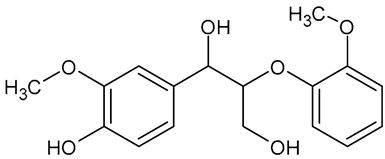 Guaiacylglycerol-β-guaiacyl ether (Gβ2) | Hydrothermal decomposition under neutral and basic conditions. Model compound (MC) (50 mg) in H2O (3 mL) with/without a base (NaOH, Na2CO3), N2, 175 °C for 15 min. | 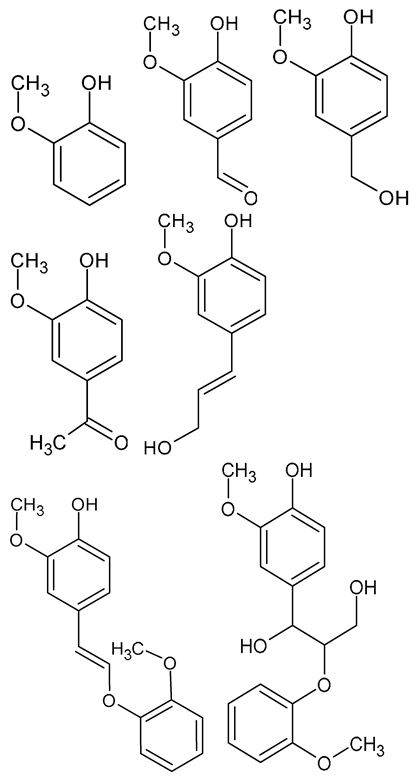 | GC-MS internal standard (IS) based quantification of silylated products including Gβ2 using N,O-bis(trimethylsilyl)trifluoroacetamide (BSTFA) quantified using standards and effective carbon number (ECN) factors, closing mass balance. | [13] |
 2-Phenylethyl phenyl ether | Catalytic cleavage in the aqueous phase. MC (1.98 g), Ni/SiO2 (0.30 g), H2O (80 mL), 6 bar H2, 120 °C, 90 min, stirring at 700 rpm. | 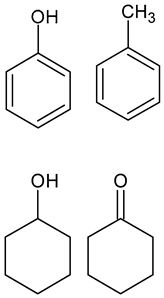 | GC-MS with IS based quantification, using 2-isopropylphenol. Specific conditions of carbon mass balance determination NR. a | [21] |
| Gβ2 | Aqueous phase hydrodeoxygenation. MC (100 μg), solid acid zeolite, H+-Y (300 mg), Ru/Al2O3 (300 mg), H2O (30 mL), 40 bar H2, 250 °C, 4 h |  | GC-MS with quantification, using n-decane as an IS. The quantification appears to be based only on normalization. Gβ2 conversion NR. a | [22] |
 2-Phenoxy-1-phenylethanol | Base promoted hydrogenolysis over metal catalysts in water. MC (10 mol%); Ni7Au3, NaOH, H2O, 10 bar H2, 130 °C, 0.5 h. |  Plus 12 minor products: 7 dimers and 8 monomers | GC-MS identification, GC-FID with quantification using standards and effective carbon number (ECN) factors. n-Dodecane was used as an IS. | [23] |
| Gβ2 | Catalysis with H2 donor agent (reduction); deoxygenation pathways under H2 transfer conditions. MC (0.067 g/L) in 50% EtOH in H2O, Pt/C (5.12 g), 80 bar, 275 °C. |  | GC-MS identification, quantification approach NR. | [24] |
| Gβ2 | Catalytic hydrogenolysis. MC (0.5 mmol). 50% THF in H2O (20 mL), Fe-L1/C-800 catalyst (0.1 g), 10 bar H2, 240 °C, 12 h. | 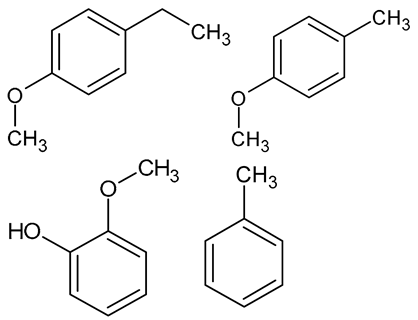 | GC-MS with IS based quantification of products using phenol, dodecane to determine toluene. Gβ2 conversion NR | [11] |
 2-Phenoxy-1-phenylethanol | Catalytic redox-neutral C–O bond cleavage. MC (0.1 mmol), Pd on metal-organic framework, EtOH/H2O at 120 °C, 6 h under N2. Pressure value NR. a | 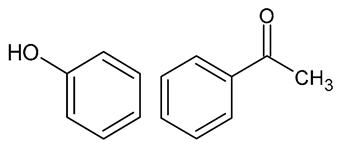 | GC-MS quantification, the quantification approach NR, Gβ2 conversion NR. a | [25] |
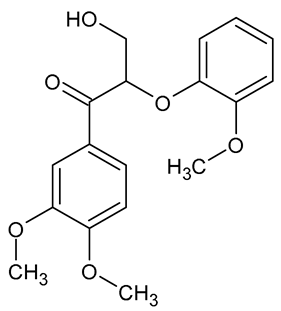 Gβ2 and its oxidized derivative | Formic acid-induced depolymerization. MCs (1 mmol), sodium formate (3 mmol), HCO2H:H2O (10:1) (5 mL), 110 °C, 12 h. Pressure value NR. | 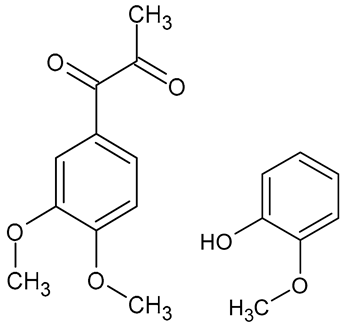 | Identification and quantification by LC-MS, LC-MS-MS and GC-MS with/without derivatization. Both products and feedstock MCs were quantified. | [14] |
 2-Phenoxyacetophenone | Bioconversion with a Gram-negative bacterium, Acinetobacter sp. TUS-SO1 cells with 0.1 g/L yeast extract and 1% (v/v) Tween 80 with MC (1 mM) in DMSO, 1% [v/v] at 30 °C for 72 h, shaking | 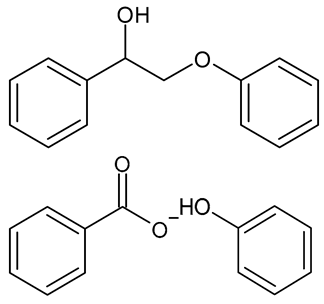 | HPLC-MS quantification of product and MC feedstock. GC-MS with trimethylsilylation confirmed identification. | [17] |
| Gβ2 | Bioconversion (Burkholderia sp. ISTR5). MC (2,000 mg/L), with overnight grown bacteria to obtain a final optical density of 0.1 at 30 °C for 72 h shaking. | 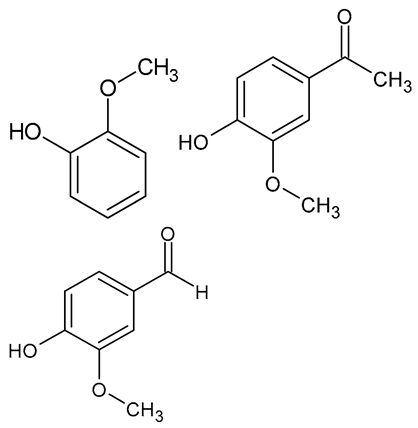 | GC-MS with BSTFA derivatization; identification of both products and MC, quantification approach NR. | [12] |
2. Materials and Methods
2.1. Materials
2.2. Assessment of Gβ2 Stability
2.3. HPLC-TOF-MS and Pyr-GC-MS Analyses
3. Results
3.1. Stability at Different pH
3.2. Evaluation of Gβ2 Biodegradation
3.3. Stability in Subcritical Water
3.4. Stability toward Mild Solvent-Free Pyrolysis
4. Conclusions
Supplementary Materials
Author Contributions
Funding
Data Availability Statement
Acknowledgments
Conflicts of Interest
References
- Guo, H.; Zhao, Y.; Chang, J.-S.; Lee, D.-J. Lignin to value-added products: Research updates and prospects. Bioresour. Technol. 2023, 384, 129294. [Google Scholar] [CrossRef]
- Jia, S.; Liu, X.; Li, X.; Sun, C.; Cao, X.; Liu, W.; Guo, G.; Bi, C. Modification of lignin composition by ectopic expressing wheat TAF5H1 led to decreased salt tolerance in transgenic arabidopsis plants. J. Plant Physiol. 2023, 287, 153997. [Google Scholar] [CrossRef] [PubMed]
- Lupoi, J.S.; Singh, S.; Parthasarathi, R.; Simmons, B.A.; Henry, R.J. Recent innovations in analytical methods for the qualitative and quantitative assessment of lignin. Renew. Sustain. Energy Rev. 2015, 49, 871–906. [Google Scholar] [CrossRef]
- Zhang, R.; Qi, Y.; Ma, C.; Ge, J.; Hu, Q.; Yue, F.-J.; Li, S.-L.; Volmer, D.A. Characterization of lignin compounds at the molecular level: Mass spectrometry analysis and raw data processing. Molecules 2021, 26, 178. [Google Scholar] [CrossRef] [PubMed]
- Sun, Z.; Fridrich, B.; de Santi, A.; Elangovan, S.; Barta, K. Bright side of lignin depolymerization: Toward new platform chemicals. Chem. Rev. 2018, 118, 614–678. [Google Scholar] [CrossRef] [PubMed]
- Chakar, F.S.; Ragauskas, A.J. Review of current and future softwood kraft lignin process chemistry. Ind. Crops Prod. 2004, 20, 131–141. [Google Scholar] [CrossRef]
- Lahive, C.W.; Kamer, P.C.; Lancefield, C.S.; Deuss, P.J. An introduction to model compounds of lignin linking motifs; synthesis and selection considerations for reactivity studies. ChemSusChem 2020, 13, 4238–4265. [Google Scholar] [CrossRef]
- Vangeel, T.; Schutyser, W.; Renders, T.; Sels, B.F. Perspective on lignin oxidation: Advances, challenges, and future directions. Lignin Chem. 2020, 376, 53–68. [Google Scholar] [CrossRef]
- Zhang, C.; Li, H.; Lu, J.; Zhang, X.; MacArthur, K.E.; Heggen, M.; Wang, F. Promoting lignin depolymerization and restraining the condensation via an oxidation−hydrogenation strategy. ACS Catal. 2017, 7, 3419–3429. [Google Scholar] [CrossRef]
- Zhang, B.; Qi, Z.; Li, X.; Ji, J.; Luo, W.; Li, C.; Wang, A.; Zhang, T. ReOx/AC-catalyzed cleavage of C–O bonds in lignin model compounds and alkaline lignins. ACS Sustain. Chem. Eng. 2019, 7, 208–215. [Google Scholar] [CrossRef]
- Li, J.; Sun, H.; Liu, J.-X.; Zhang, J.-J.; Li, Z.-X.; Fu, Y. Selective reductive cleavage of C-O bond in lignin model compounds over nitrogen-doped carbon-supported iron catalysts. Mol. Catal. 2018, 45, 236–245. [Google Scholar] [CrossRef]
- Morya, R.; Kumar, M.; Thakur, I.S. Bioconversion of guaiacylglycerol-β-guaiacyl ether into vanillin by Burkholderia sp. ISTR5: A genomic and proteomic approach. Int. Biodet. Biodegr. 2021, 161, 105231. [Google Scholar] [CrossRef]
- Nagel, E.; Zhang, C. Hydrothermal decomposition of a lignin dimer under neutral and basic conditions: A mechanism study. Ind. Eng. Chem. Res. 2019, 58, 18866–18880. [Google Scholar] [CrossRef]
- Rahimi, A.; Ulbrich, A.; Coon, J.J.; Stahl, S.S. Formic-acid-induced depolymerization of oxidized lignin to aromatics. Nature 2014, 515, 249–252. [Google Scholar] [CrossRef] [PubMed]
- Kozliak, E.I.; Kubátová, A.; Artemyeva, A.A.; Nagel, E.; Zhang, C.; Rajappagowda, R.B.; Smirnova, A.L. Thermal liquefaction of lignin to aromatics: Efficiency, selectivity, and product analysis. ACS Sustain. Chem. Eng. 2016, 4, 5106–5122. [Google Scholar] [CrossRef]
- Pawliszyn, J. Sampling and Sample Preparation in Field and Laboratory: Fundamentals and New Directions in Sample Preparation; Elsevier: Amsterdam, The Netherlands, 2002. [Google Scholar]
- Oya, S.; Tonegawa, S.; Nakagawa, H.; Habe, H.; Furuya, T. Isolation and characterization of microorganisms capable of cleaving the ether bond of 2-phenoxyacetophenone. Sci. Rep. 2022, 12, 2874. [Google Scholar] [CrossRef] [PubMed]
- Parnell, J.J.; Park, J.; Denef, V.; Tsoi, T.; Hashsham, S.; Quensen, J., III; Tiedje, J.M. Coping with polychlorinated biphenyl (PCB) toxicity: Physiological and genome-wide responses of Burkholderia xenovorans LB400 to PCB-mediated stress. Appl. Environ. Microbiol. 2006, 72, 6607–6614. [Google Scholar] [CrossRef]
- Bugg, T.D.H.; Rahmanpour, R. Enzymatic conversion of lignin into renewable chemicals. Curr. Op. Chem. Biol. 2015, 29, 10–17. [Google Scholar] [CrossRef]
- Ahmad, M.; Roberts, J.N.; Hardiman, E.M.; Singh, R.; Eltis, L.D.; Bugg, T.D.H. Identification of DypB from Rhodococcus jostii RHA1 as a lignin peroxidase. Biochemistry 2011, 50, 5096–5107. [Google Scholar] [CrossRef]
- He, J.; Zhao, C.; Lercher, J.A. Ni-catalyzed cleavage of aryl ethers in the aqueous phase. J. Am. Chem. Soc. 2012, 134, 20768–20775. [Google Scholar] [CrossRef]
- Wang, H.; Ruan, H.; Pei, H.; Wang, H.; Chen, X.; Tucker, M.P.; Cort, J.R.; Yang, B. Biomass-derived lignin to jet fuel range hydrocarbons via aqueous phase hydrodeoxygenation. Green Chem. 2015, 17, 5131–5135. [Google Scholar] [CrossRef]
- Konnerth, H.; Zhang, J.; Ma, D.; Prechtl, M.H.G.; Yan, N. Base promoted hydrogenolysis of lignin model compounds and organosolv lignin over metal catalysts in water. Chem. Eng. Sci. 2015, 123, 155–163. [Google Scholar] [CrossRef]
- Besse, X.; Schuurman, Y.; Guilhaume, N. Reactivity of lignin model compounds through hydrogen transfer catalysis in ethanol/water mixtures. Appl. Catal. B Environ. 2017, 209, 265–272. [Google Scholar] [CrossRef]
- Ahsan Usman, M.; Naeem, M.; Saeed, M.; Zaheer, M. Catalytic C-O bond cleavage in a β-O-4 lignin model through intermolecular hydrogen transfer. Inorg. Chim. Acta 2021, 521, 120305. [Google Scholar] [CrossRef]
- Schumaker, J. Quantification of Lignin Hydroxyl Containing Functional Groups via 31P[1H] NMR Spectroscopy and Synthesis of Lignin Degradation Standards. M.S. Thesis, University of North Dakota, Grand Forks, ND, USA, 2017. [Google Scholar]
- Uhlik, O.; Jecna, K.; Mackova, M.; Vlcek, C.; Hroudova, M.; Demnerova, K.; Paces, V.; Macek, T. Biphenyl-metabolizing bacteria in the rhizosphere of horseradish and bulk soil contaminated by polychlorinated biphenyls as revealed by stable isotope probing. Appl. Environ. Microbiol. 2009, 75, 6471–6477. [Google Scholar] [CrossRef] [PubMed]
- Voeller, K.; Bílek, H.; Kreft, J.; Dostálková, A.; Kozliak, E.; Kubátová, A. Thermal carbon analysis enabling comprehensive characterization of lignin and its degradation products. ACS Sustain. Chem. Eng. 2017, 5, 10334–10341. [Google Scholar] [CrossRef]
- Harvey, A.H.; Peskin, A.P.; Klein, S.A. NIST/ASME Steam Formulation Database 10; National Institute of Standards and Technology: Gaithersburg, MD, USA, 1996.
- Jasiukaitytė-Grojzdek, E.; Huš, M.; Grilc, M.; Likozar, B. Acid-catalysed α-O-4 aryl-ether bond cleavage in methanol/(aqueous) ethanol: Understanding depolymerisation of a lignin model compound during organosolv pretreatment. Sci. Rep. 2020, 10, 11037. [Google Scholar] [CrossRef] [PubMed]
- Wang, L.; Yin, J.; Jiang, J.; Zhang, Y.; Song, M.; Zhang, R.; Dong, Z.; Yang, H.; Yu, H. Revealing G-lignin model compounds pyrolysis behavior: β-O-4 and 5-5′ dimer and trimer. Fuel 2022, 317, 123531. [Google Scholar] [CrossRef]
- Liu, Y.; Lyu, G.; Ji, X.; Yang, G.; Chen, J.; Lucia, L.A. Analytical pyrolysis pathways of guaiacyl glycerol-β-guaiacyl ether by py-gc/ms. BioRes. 2016, 11, 5816–5828. [Google Scholar] [CrossRef][Green Version]
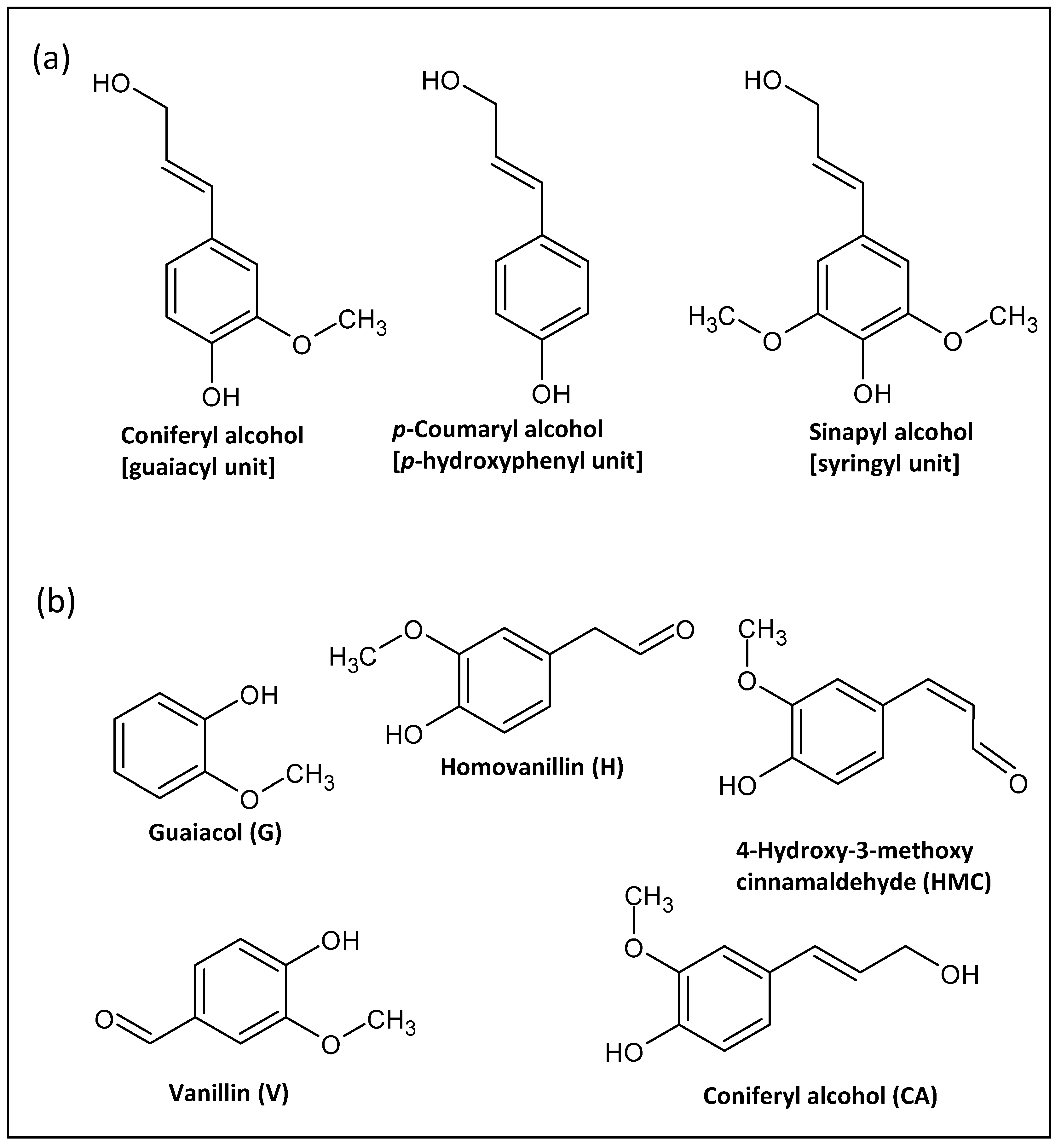


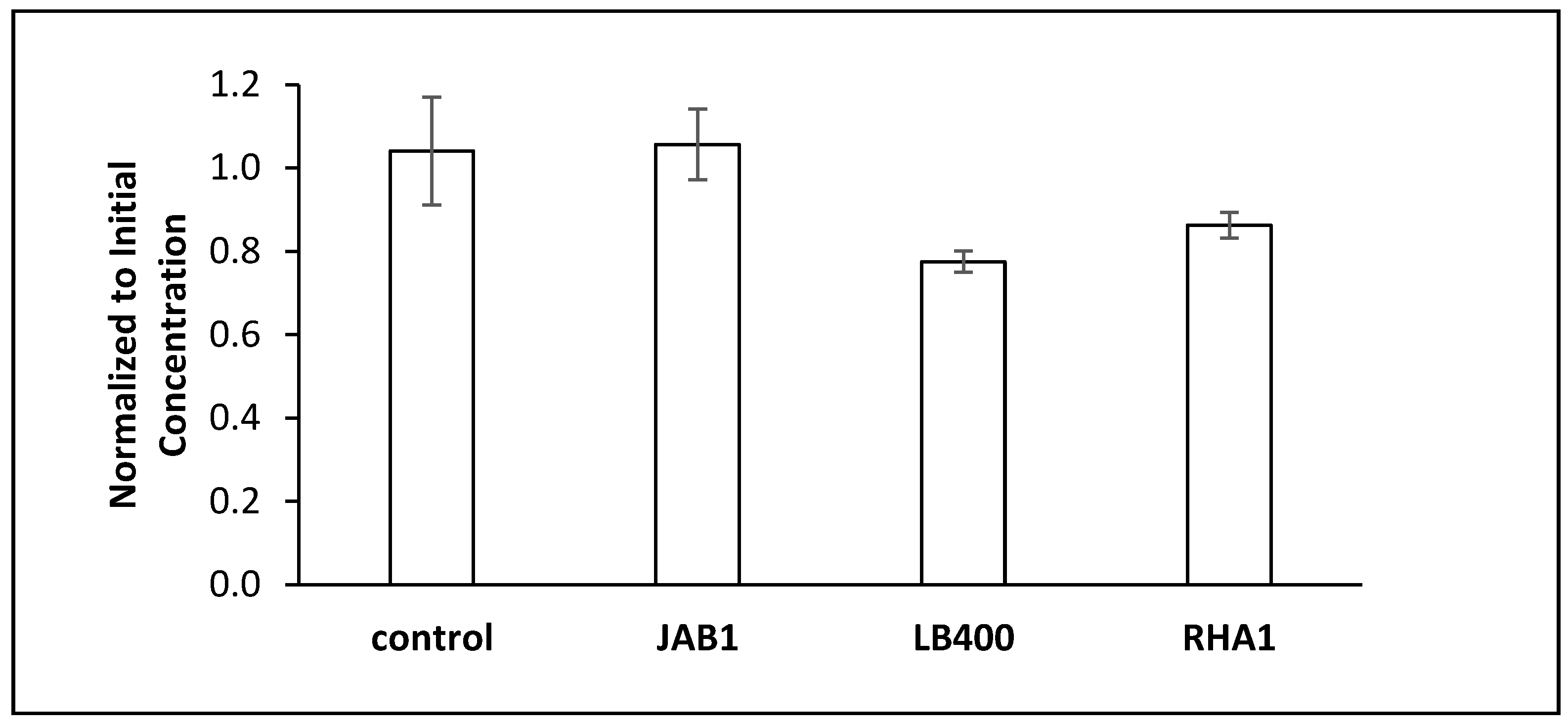
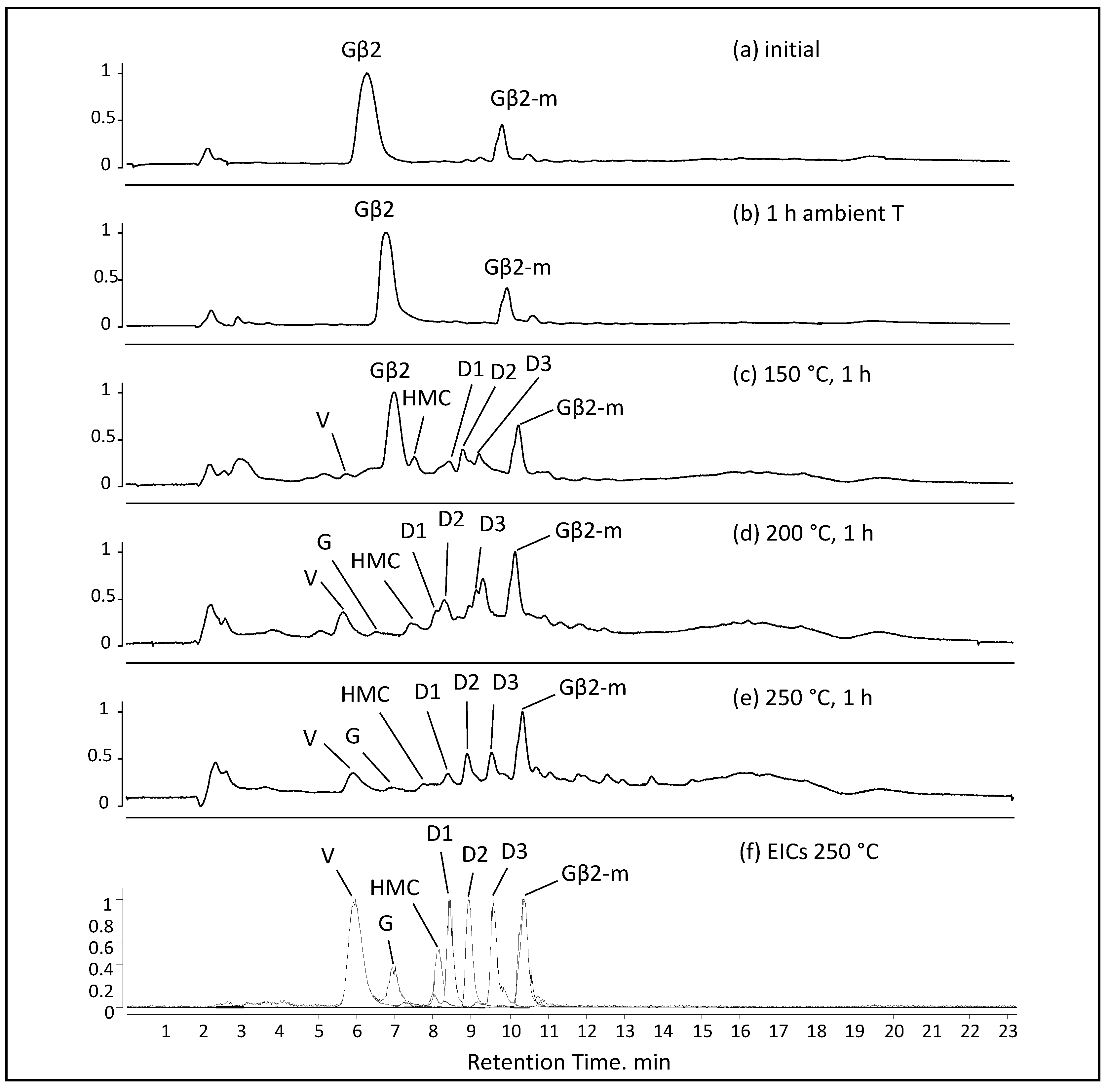

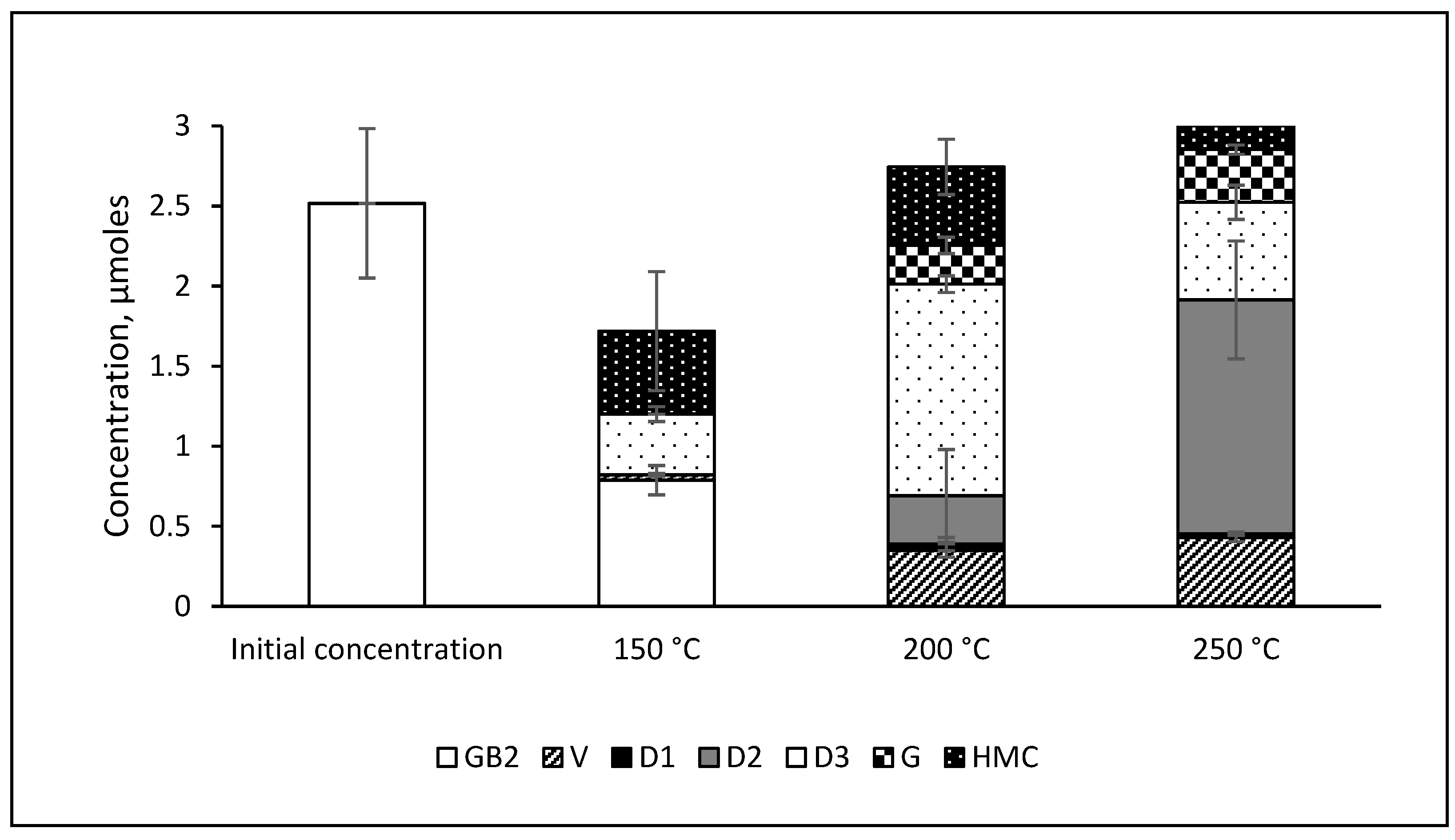


| Reaction temperature (°C) | 150 | 200 | 250 |
| Water saturation pressure (bar) | 4.780 | 15.55 | 39.76 |
| Liquid phase density (g/cm3) | 0.9167 | 0.8647 | 0.7989 |
| Vapor density (g/cm3) | 0.002545 | 0.007861 | 0.01997 |
| Compound Name, Abbreviation | Retention Time, min | Monoisotopic Mass, m/z | Quantification Ion [M + H]+ m/z | Confirmation Ion [M + Na]+ m/z | ID & Quant. Confirmation * |
|---|---|---|---|---|---|
| Guaiacylglycerol-β-guaiacyl ether, Gβ2 | 7.1 | 320.1260 | 321.1333 | 343.1152 | Standard |
| Vanillin, V | 5.9 | 152.0473 | 153.0546 | 175.0366 | Standard |
| Guaiacol, G | 6.9 | 124.0524 | 125.0597 | 147.0416 | Standard |
| 4-Hydroxy-3-methoxy cinnamaldehyde, HMC | 7.8 | 178.0630 | 179.0703 | 201.0522 | Standard |
| 1-(2′-Methoxyphenoxy)-2-(4′-hydroxy-3′-methoxyphenyl)ethane, D1 | 8.4 | 274.1205 | 275.1278 | 297.1097 | Tentative |
| 3-Hydroxy-2-phenoxy-1-(4′-hydroxy-3′-methoxyphenyl)-1-propanone, D2 | 8.9 | 288.0998 | 289.1071 | 311.0890 | Tentative |
| 2-(2′-Methoxyphenoxy)-3-(4′-hydroxy-3′-methoxyphenyl)propanal, D3 | 9.5 | 302.1154 | 303.1227 | 325.1046 | Tentative |
| Compound Name, Abbreviation | Retention Time (min) | Molecular Ion m/z | Identification Type * |
|---|---|---|---|
| Vanillin, V | 6.7 | 152 | Standard |
| Guaiacol, G | 4.9 | 124.1 | Standard |
| 2-(2′-Methoxyphenoxy)-3-(4′-hydroxy-3′-methoxyphenyl)propanol, D3 | 11.3 | 302.1 | Tentative |
| Cis/trans-1,2-Di(4′-hydroxy-3′-methoxyphenyl) ethene, D4 | 11.6, 11.8, 12.8 for isomers | 272.1 | Tentative |
| 4-Hydroxy-3-methoxy cinnamaldehyde | 7.6 | 178.1 | Standard |
| Coniferyl alcohol, CA | 9.3 | 180.1 | Tentative |
| Homovanillin, H | 6.3 | 166.1 | Tentative |
Disclaimer/Publisher’s Note: The statements, opinions and data contained in all publications are solely those of the individual author(s) and contributor(s) and not of MDPI and/or the editor(s). MDPI and/or the editor(s) disclaim responsibility for any injury to people or property resulting from any ideas, methods, instructions or products referred to in the content. |
© 2024 by the authors. Licensee MDPI, Basel, Switzerland. This article is an open access article distributed under the terms and conditions of the Creative Commons Attribution (CC BY) license (https://creativecommons.org/licenses/by/4.0/).
Share and Cite
Rabiei, Z.; Simons, A.; Folkmanova, M.; Vesela, T.; Uhlik, O.; Kozliak, E.; Kubátová, A. Stability and Reactivity of Guaiacylglycerol-β-Guaiacyl Ether, a Compound Modeling β-O-4 Linkage in Lignin. Separations 2024, 11, 59. https://doi.org/10.3390/separations11020059
Rabiei Z, Simons A, Folkmanova M, Vesela T, Uhlik O, Kozliak E, Kubátová A. Stability and Reactivity of Guaiacylglycerol-β-Guaiacyl Ether, a Compound Modeling β-O-4 Linkage in Lignin. Separations. 2024; 11(2):59. https://doi.org/10.3390/separations11020059
Chicago/Turabian StyleRabiei, Zeinab, Andrew Simons, Magdalena Folkmanova, Tereza Vesela, Ondrej Uhlik, Evguenii Kozliak, and Alena Kubátová. 2024. "Stability and Reactivity of Guaiacylglycerol-β-Guaiacyl Ether, a Compound Modeling β-O-4 Linkage in Lignin" Separations 11, no. 2: 59. https://doi.org/10.3390/separations11020059
APA StyleRabiei, Z., Simons, A., Folkmanova, M., Vesela, T., Uhlik, O., Kozliak, E., & Kubátová, A. (2024). Stability and Reactivity of Guaiacylglycerol-β-Guaiacyl Ether, a Compound Modeling β-O-4 Linkage in Lignin. Separations, 11(2), 59. https://doi.org/10.3390/separations11020059







